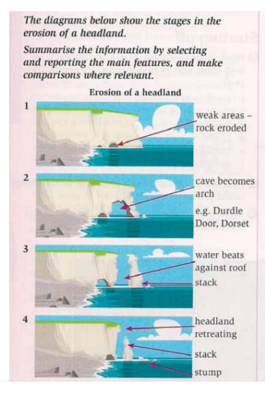The diagrams illustrate the erosion process that take place in a headland. Overall, there are four paces that can be seen. Interestingly, the process has natural stepped without intervention of human being.
According to the picture, weak area can be found in the bottom of headland which is caused by abraded rock. As the time passes by, the erosion has extended and led to the arch cave, such as durdle, door, or door set. Eventually, the structure of headland becomes weaker, so that tide can easily beat against the roof.
As a consequence, the roof is fallen and stack is separated from the headland. Meanwhile, top of the stack is cracking and collapsing to the sea. Afterwards, the rock erosion continues to experience in the same area which retreat the headland and wore away the stump. This nature process is usually happened in the high cliff of seashore with powerful waves.
According to the picture, weak area can be found in the bottom of headland which is caused by abraded rock. As the time passes by, the erosion has extended and led to the arch cave, such as durdle, door, or door set. Eventually, the structure of headland becomes weaker, so that tide can easily beat against the roof.
As a consequence, the roof is fallen and stack is separated from the headland. Meanwhile, top of the stack is cracking and collapsing to the sea. Afterwards, the rock erosion continues to experience in the same area which retreat the headland and wore away the stump. This nature process is usually happened in the high cliff of seashore with powerful waves.

Writing_44_Task_1.pn.png
